Published: 28 August 2019
Index of wage and salary earnings rose by 2.5 percent in April-June
According to preliminary data of Statistics Finland, the nominal earnings of wage and salary earners rose by 2.5 per cent in April to June 2019 when compared with the respective period in 2018. Real earnings rose by 1.3 per cent compared to the second quarter of the previous year, because the rise in earnings level was faster than that in consumer prices.
Index of wage and salary earnings and real earnings 2000/1 to 2019/2, annual change percentage
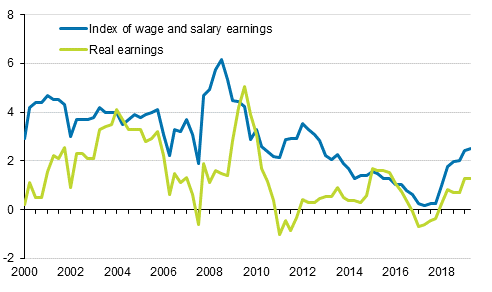
Non-recurring item and contractual pay increases visible in earnings development in 2019
According to Statistics Finland’s preliminary data, the nominal earnings of wage and salary earners rose from April to June 2018 to the corresponding period in 2019 by 2.2 per cent in the private sector, by 3.4 per cent in the central government sector and by 3.8 per cent in the local government sector.
The figure examines the development of the index of wage and salary earnings (ATI) in 2015 to 2019. The private sector, central government sector and local government sector are examined, and the examination ends in the last published quarter, that is, the second quarter of 2019. The earnings development made an upturn in both the state and municipal sectors at the beginning of 2019. This is affected by the non-recurring item based on profitability paid in the central and local government sector in January 2019. Furthermore, the wages and salaries in the public sector rose due to local sectoral allowances and an overall increase, which occurred in the first half of 2019.
Development of the index of wage and salary earnings 2015=100 by employer sector
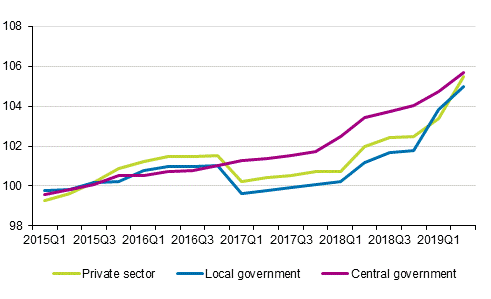
Wage and salary earners’ regular earnings increased by 2.3 per cent in April to June
The index for regular earnings describes the permanent change in earnings better than the index of wage and salary earnings because it does not take into account performance-based bonuses and non-recurring items included in collective agreements. For instance, the non-recurring item based on profitability paid in the public sector does not affect the index for regular earnings. Regular earnings rose by 2.3 per cent in April to June 2019 when compared with the respective period in 2018. The growth amounted to 2.2 per cent in the private sector, to 2.7 per cent in the central government sector, and to 3.0 per cent in the local government sector.
According to preliminary data, earnings of wage and salary earners were 2.4 percent higher in July to September than in the year before
According to Statistics Finland’s preliminary data, nominal earnings of wage and salary earners are 2.4 per cent higher in July to September 2019 than in July to September 2018. According to preliminary data, the index of wage and salary earnings 2015=100 for the third quarter of 2019 is 105.6. Statistics Finland compiles the preliminary third quarter data for the index of wage and salary earnings on the basis of the Employees Pensions Act (2006/395).
Differences in index of negotiated wages and salaries evened out
The figure examines the development of the index of negotiated wages and salaries 2010=100 in 2010 to 2019. Employer sectors total, private sector and local government sector were selected to the examination. The index of negotiated wages and salaries in the private sector remained unchanged in 2017, when there were, in practice, no contractual pay increases. The index turned upwards in the first quarter of 2018 and continued rising in the beginning of 2019.
Development of the index of negotiated wages and salaries 2010=100 by employer sector
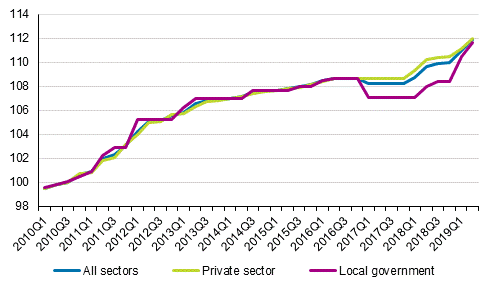
In the local government sector, the index of negotiated wages and salaries fell in the first quarter of 2017, because the reduction in public sector holiday bonuses agreed on in the Competitiveness Pact is also visible in the development of the index of negotiated wages and salaries. In 2017, the index of negotiated wages and salaries in the local government sector remained unchanged and turned upwards in the second quarter of 2018. The rise continued in the beginning of 2019, when a non-recurring item based on profitability was paid in the local government sector. It amounted to 9.2 per cent of the monthly pay of those entitled to the non-recurring item. Furthermore, the local government sector wages and salaries rose due to local sectoral allowances in January and an overall increase in April 2019.
In the central government sector, the development of the index of negotiated wages and salaries has in recent years largely followed the development of the index of negotiated wages and salaries in the local government sector.
Wage drift and contractual pay increases vary by industry
The indices of wage and salary earnings and the indices for regular earnings are final until 2018. They are based on the realised earnings development. The indices for 2019 are preliminary and they are based on estimates of agreement effects and the wage drift.
Earnings development consists of contractual pay increases and wage drift. These together form the earnings development in accordance with the index of wage and salary earnings, and it includes agreement-based non-recurring items and performance-based bonuses. The figure presents the earnings development on the level of main activity categories in the Standard Industrial Classification so that contractual pay increases and wage drift are separated. The examination ends in 2018 because the data are based on realised earnings as far as that year.
Earnings development by industry (TOL2008) in 2015 to 2018
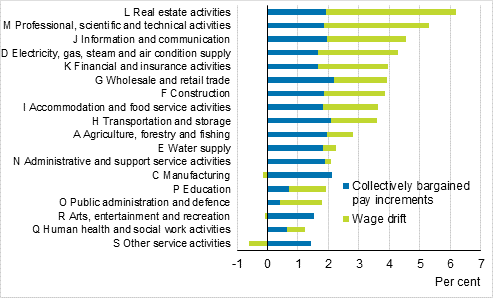
In 2015 to 2018, the development of earnings was fastest in the industry of real estate activities (6.2 per cent) and in the industry of professional, scientific and technical activities (5.3 per cent). In these industries, the share of wage drift of earnings development was also largest. The development of earnings was slowest in the industries other service activities (0.8 per cent) and human health and social work activities (1.2 per cent). In the industry other service activities, as well as in the industries of manufacturing and arts, entertainment and recreation, the wage drift was negative in 2015 to 2018. However, the earnings development was not negative in these industries, because earnings development consists of contractual pay increases in addition to wage drift.
In 2015 to 2018, the share of contractual pay increases of earnings development was highest in the industries of trade (2.2 per cent), manufacturing (2.1 per cent) and transportation and storage (2.1 per cent). The contractual pay increases were, in turn, smallest in the industries of public administration (0.4 per cent), human health and social work activities (0.6 per cent) and education (0.7 per cent).
When examining the figure, it should be borne in mind that in the Competitiveness Pact it was agreed to extend collective agreements by 12 months so that wages and salaries remain unchanged for the duration of the extended agreement period. As a result, contractual pay increases occurred only in individual industries in 2017. In addition, earnings development is affected by the structural change in the industry. The following section examines the effect of changes in the occupational structure on the development of average earnings.
Change in occupational structure affects the development of average earnings
Since 2013, Statistics Finland has published an index standardised with the main category of occupation based on the index for regular earnings, in which the shares of the main categories of occupation for each wage and salary earner group are standardised based on the wage and salary sum weights of 2010. There are ten of these main categories of occupation, from managers to other workers. By comparing the index standardised with occupation and the index for regular earnings, we can examine how changes in the occupational structure of the employer sector influence the development of average earnings in the same employer sector. Employer sector specific data in the index standardised with occupation can be found in the database tables of the statistics on index of wage and salary earners (Index of regular earnings fixed by the main category of occupations by employer sector).
From 2010 to 2018, the change in the occupational structure has accelerated the rise in average earnings both in the central and local government sectors. The figure shows how the index for regular earnings has risen more in the central and local government sectors in 2010 to 2018 than the index standardised with occupation. For example, in the occupational group of professionals, wage and salary earners usually have a higher university degree, and in these occupations the earnings level is also higher than average. If the share of professionals grows in the central government sector, this leads to a faster rise in average earnings in the central government sector. This is particularly visible in the earnings development of the central and local government sectors. In recent years, the index of regular earnings has risen more than the index standardised for occupation and at the same time the share of professionals has risen, particularly in the central government sector.
Change in earnings by employer sector and according to the index for regular earnings and the index standardised with the main category of occupation 2010=100
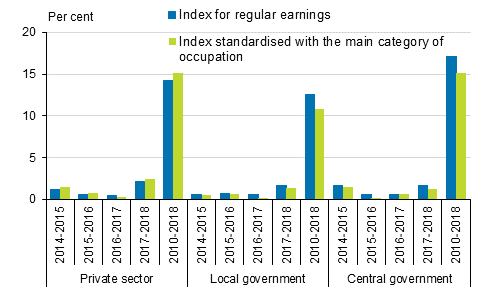
In the private sector, the index standardised for occupation has risen in 2010 to 2018 more than the index for regular earnings, but in 2016 to 2017, for example, the index for regular earnings has risen more than the index standardised for occupation. At the same time, the share of professionals has grown in the private sector.
Number of clerical support workers decreased clearly during this decade
With the help of the index standardised for occupational structure, the earnings development of wage and salary earners in each main occupational group can be compared. The most common occupational main groups, where the wage and salary earners usually are monthly-paid employees, are professionals, technicians and associate professionals, clerical support workers and service and sales workers. Of these, professionals have had the fastest earnings development from 2010 to 2018, 15.1 per cent, and clerical support workers the slowest, 11.8 per cent.
Change in earnings for regular working hours and numbers in the most common main categories of occupation in 2010 to 2018
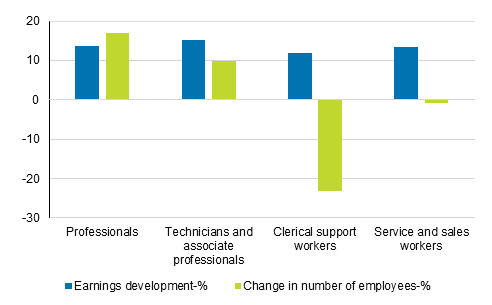
From 2010 to 2018, the number of clerical support workers has contracted by almost 22 per cent. At the same time, the number of professionals has increased by close on 14 per cent. Among salaried employees, the change in occupational structure has, thus, been strong in the direction of highly educated occupational groups. These numbers have been calculated from the data included in the statistics on wages and salaries, but the changes are similar in the employment statistics containing more detailed data.
Change in earnings for regular working hours and numbers in the most common main categories of occupation in hourly-paid branches in 2010 to 2018
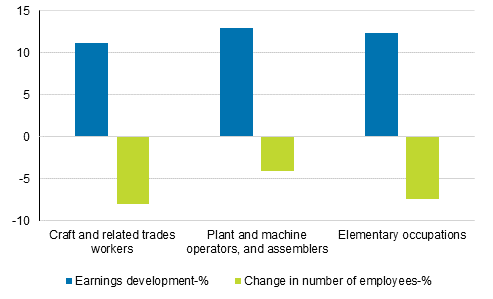
In hourly-paid branches, earnings development has been fastest in 2010 to 2018 for plant and machine operators, and assemblers, 13 per cent and slowest for craft and related trades workers, 11 per cent. The number of wage and salary earners has decreased in all these main occupational categories, most among craft and related trades workers, by eight per cent.
Source: Index of wage and salary earnings 2019, 2nd quarter. Statistics Finland
Inquiries: Anu Uuttu 029 551 2322, Harri Nummila 029 551 3235, palkat.indeksit@stat.fi
Director in charge: Mari Ylä-Jarkko
Publication in pdf-format (507.0 kB)
- Tables
-
Tables in databases
Pick the data you need into tables, view the data as graphs, or download the data for your use.
Appendix tables
- Appendix table 1. Index of wage and salary earnings 2015=100 by employer sector and base of payment (28.8.2019)
- Appendix table 2. Index of regular earnings 2015=100 by employer sector and base of payment (28.8.2019)
- Appendix table 3. Index of wage and salary earnings 2015=100 by employer sector and gender (28.8.2019)
- Appendix table 4. Index of regular earnings 2015=100 by employer sector and gender (28.8.2019)
- Appendix table 5. Index of wage and salary earnings 2015=100 by industry, (TOL 2008) (28.8.2019)
- Appendix table 6. Index of regular earnings 2015=100 by industry, (TOL 2008) (28.8.2019)
- Appendix table 7. Index of wage and salary earnings 2010=100 by employer sector and gender (28.8.2019)
- Appendix table 8. Index of wage and salary earnings 2010=100 by industry, (TOL 2008) (28.8.2019)
- Appendix table 9. Index of wage and salary earnings 2015=100, percentage changes (28.8.2019)
- Appendix table 10. Index of regular earnings 2015=100, percentage changes (28.8.2019)
- Appendix table 11. Average earnings by employer sector and gender, EUR/month (28.8.2019)
- Revisions in these statistics
-
- Revisions in these statistics (28.8.2019)
Updated 28.08.2019
Official Statistics of Finland (OSF):
Index of wage and salary earnings [e-publication].
ISSN=1798-7814. 2nd quarter 2019. Helsinki: Statistics Finland [referred: 16.11.2025].
Access method: http://stat.fi/til/ati/2019/02/ati_2019_02_2019-08-28_tie_001_en.html

